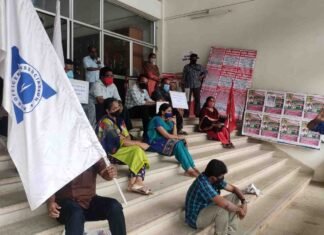
Abrogation of the cross subsidy system
The cross‐subsidy system in electricity tariff is followed in all the States which results in tariffs higher than the average cost of supply for consumers like commercial customers, industrial customers etc who consume electricity in large quantum. It also allows tariffs lower than the average cost of supply for low end domestic consumers and small scale industries. Roughly about 75% of the domestic consumers in Kerala are presently paying electricity tariffs at far less rates than the cost of supply due to cross subsidy structure in tariff. Currently the distribution15 utilities could serve these sections since part of the burden is shared by the wealthy households and profitable business ventures through cross subsidy in their tariff. Once these consumers who are paying at rates much above the cost of supply are selectively picked up by the new supply licensees, no one will be left to share the burden.
Section 61 (1) (g) of the proposed amendment limits the maximum extent of cross subsidy to 20 % which is to be eliminated totally in three years. The provision for levying cross subsidy surcharge to open access consumers in Sections 38 to 40 has also been eliminated in the draft. An amendment is proposed in Section 42 of the Act regarding cross subsidy surcharge which is ‘Provided that such open access shall be allowed on payment of wheeling charges and a surcharge thereon as may be determined by the State Commission; provided that the surcharge shall not be more than twenty percent of the wheeling charges. Provided also that such surcharge shall be progressively reduced and eliminated in two years in the manner as may be specified by the State Commission’. The proviso is basically flawed. Cross subsidy surcharge is not a function of wheeling charge, but is related to tariff structure.
Subsequent transfer of subsidy or ‘direct benefit transfer scheme’ which is presented as a remedy in lieu of the cross subsidy system, has been a fiasco in several other sectors and is likely to be even more disastrous here, as most of the consumers benefitting the cross subsidy system have limited upfront paying capacity. Considering the huge consumer base, transferring of subsidy to individual bank accounts of consumers may not be practical either. The present level of subsidy commitment of the State government in Kerala is less than 400 Crores per year. If the cross subsidy system is eliminated, the subsidy commitment required to maintain the same level of retail tariff, would be more than 2000 Crores, which would break the financial backbone of the State, and is unenforceable as such. Hence, the Section 61 (1) (g) and 42 of the proposed amendment mentioned above may kindly be dropped. Considering all the factors presented above, the provision for levying cross subsidy surcharge may please be restored.
Selection of the State Electricity Regulatory Commission
The State Government is vested with the power to appoint the Chairman and Members of the State Electricity Regulatory Commission. But the selection committee has been reconstituted comprehensively in the draft amendment. The committee in the amended form provided in Section 85 of the Act comprises
of six members of which five are nominees of the Central Government. The Chairman as well as the Member Secretary, who moots the agenda of the Committee, is to be nominated by the Central Government. Composition of the committee obviously leaves no room for the State for exercising any meaningful control. For effective regulatory intervention, the Members and Chairman of the Commission are to have sufficient exposure to and experience in the State Power Sector and are to have an awareness of the peculiarities of the Sector in the State and the priorities therein. To enable this, a meaningful role of the State in the selection process is essential. As such, the amendment proposed in Section 85 of the Act may please be withdrawn.
The negation of the spirit of federalism and State-specific solutions
Electricity is not within the exclusive domain of the Central Government, as per the Constitution of India. The item is placed in the concurrent list in the 7th Schedule of the Constitution.
Constitutional propriety requires the Central Government to allow a stake for each State in deciding matters within it’s jurisdiction, considering the endemic peculiarities, the stage of development, general aspirations as well as the general development road map. Besides being in line with the general spirit of federalism enshrined in the Constitution, it is the most practical approach as well. It is to be understood that the power sector in each state has evolved independent to each other and are presently in varied stages of evolution. The comparison of the vital parameters of power sector in a state like the percentage of electrification, power availability, peculiarities of the load curve, consumer mix as well as extent of metering would reveal that the conditions are entirely disparate. The challenges that confront the power sector in each state are different, likewise are the solutions. The policies adopted for mitigation of problems faced are different for each state as well as the strategies for growth. The draft amendment proposes certain rigid policies intended for uniform implementation throughout the nation, which is a sure recipe for retardation of growth in evolved power sectors as that of Kerala. The concept of ‘Pan Indian Panaceas’ in power sector is absolutely illogical, unrealistic, impractical and portends of a future of overloaded/ underdeveloped systems as well as dissatisfied or even bankrupt stakeholders including consumers.
Section 11 of the draft amendment empowers the Central Government to control all generating stations within any State other than those owned by the State itself. This power, if exercised may create unwarranted hardships to the parties who have contracted the power and may be detrimental to the interests of the State in general, besides being an infringement of the spirit of federalism. In such conditions, it is suggested that the power shall only be exercised after ensuring consent of the respective State Governments and providing adequate compensation.
Each state should be enabled by loose leashes to formulate state specific solutions to address endemic challenges and to evolve the power industry, the mother of all industries in harmony with the general development perspective of the State. Such an approach would be rooted in constitutional propriety and would be in consonance with the spirit of federalism that the Constitution upholds.
Self-defeating provisions regarding markets and power procurement
The Act proposes to promote the development of a market in power in Section 66 and goes to the extent of proposing the development of forwards and futures contract in electricity. The newly inserted subsection 2 of section 42 of the draft proposes that the distribution licensee or supply licensee, as the case may be, shall tie up long term/medium-term power purchase agreements to meet the annual average demand of power of the area which it has the obligation to serve. The condition curtails the scope of developing a dynamic power market, as compliance with this condition may lead to a situation where trading becomes unnecessary. This condition coupled with the newly inserted section 66 A which proposes mandatory enforcement of all power purchase agreements, once approved by the Appropriate Commission, would undoubtedly stifle the life out of the power market even if it survives in any manner.
It is an accepted fact that at least reasonable competition is necessary for any market driven reform to succeed. The scenario envisioned by the proposed amendment tends to promote competition in retail power sector and non competitive tie ups in bulk power purchase. This is a serious logical incongruity and is likely to make the envisaged system unviable. Encouraging competition at one end and restricting or virtually banning it in another end of the same value chain would definitely be self defeating as stated above. The experience of the State of California, United States of America is worth remembering at this juncture, where competition was permitted in bulk power procurement and was restricted in retail power pricing. This condition of stifled competition ended up in failure of the system there. Considering the incongruities in policies and procedures stated above, the proposed reforms are likely to yield the same result here also.
Section 42 (2) of the draft amendment mandates every licensee to contract enough power to meet the annual average demand of power of the area which it has obligation to serve. In a situation where more than one supply licensee operate in the same area, each such licensee tying up power enough to meet the annual average demand, shall lead to gross over contracting of power, making operation of licensees financially unviable and to idling of generation assets. This would unnecessarily push up the cost of power also. The situation is likely to be even more serious, considering the provisions for deemed licensees like Special Economic Zones and Renewable Generators that require no license for supply of electricity, with the area of supply of a licensee.
The infatuation towards purchase agreements and notions regarding their inviolability are to cause several operational hardships to licenses. It may lead to situations where a supply licensee may be unable to procure available, reasonably priced power from generators or traders without conforming to the common PPA grind. As the licenses are obliged to provide power 24 X 7, at reasonable rates, they shall be allowed the freedom to procure available power without unnecessary statutory hurdles. It is suggested that a system permitting ad hoc PPAs with willing generators or traders at ceiling rates fixed by the Commission regulating the supply licensee.
Infringement of the Regulator’s domain, contrary to the spirit of the parent law
The general spirit of the repealed Electricity Regulatory Commissions Act 1998 and the Electricity Act 2003 is distancing the Government machinery form the process of evolving regulations and fixing tariffs. Third paragraph of the ‘Statement of Objectives’ of the Electricity Act 2003 projects ‘distancing the Government from the processes of evolving regulations and determining tariff’ as a prominent objective of the Act. The spirit of the parent Act, the Electricity Act 2003 is that all such functions are to be carried through quasi‐judicial processes, by the regulator.
Several inclusions and alterations suggested in the draft tread in a direction opposite to this spirit of the parent Act. The draft amendment tends to narrow down the Regulator’s domain, whereby the scope of all related quasi‐judicial processes gets curtailed. The Regulator would be forced to function in line with Rules framed by the Government. This is against the general concept of fairness and stakeholder participation envisioned in the parent Act and is absolutely retrograde.

























